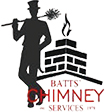We cannot stress too strongly the importance of regular chimney inspections for maintaining a safe and efficient home. A well-maintained chimney not only ensures the safe operation of your fireplace or stove but also prevents potential hazards like chimney fires and carbon monoxide intrusion. Here’s the chimney inspection checklist we use to help ensure your home’s chimney is performing safely and efficiently.
Before diving into the checklist, it’s important to learn the basic parts of your chimney: the flue, damper, chimney cap, and firebox. Each plays a crucial role in the safe and efficient operation of your chimney.
Exterior Inspection
- Chimney Structure – Check the overall structure of the chimney. Look for cracks, loose bricks, or missing mortar. Structural issues can lead to serious problems like collapsing chimneys.
- Chimney Cap and Crown – Ensure that the chimney cap is in place and in good condition. The crown, which is the concrete top of the chimney, should be free of cracks and gaps.
- Flashing – This is where the chimney meets the roof. It should be sealed properly to prevent water from entering the home.
Interior Inspection
- Firebox – Inspect the firebox for cracks or damage. The firebox walls should be intact without any loose bricks or missing mortar.
- Damper – Ensure the damper opens, closes, and seals properly. A malfunctioning damper can lead to heat loss and difficulty in controlling fires.
- Flue – Using a flashlight, check the flue for any blockages, such as bird nests, leaves, or excessive soot buildup. A blocked flue can lead to dangerous situations like carbon monoxide buildup.
- Creosote Buildup – Creosote is a highly flammable substance that builds up inside the chimney flue. If you notice a thick, tar-like buildup, it’s time for a professional cleaning.
Safety Checks
- Smoke and Carbon Monoxide Detectors – Ensure that smoke and carbon monoxide detectors are installed and functioning properly in your home.
- Clearance – Check the area around the hearth. There should be no combustible materials like paper, curtains, or furniture too close to the fireplace.
Chimney Maintenance Tips
- Regular Cleaning – Schedule a professional chimney sweep at least once a year to clean and inspect your chimney, especially if you use your fireplace frequently.
- Burning the Right Wood – Use only dry, seasoned wood. Green or wet wood creates more smoke and contributes to creosote buildup.
- Avoid Overloading – Don’t overload your fireplace. Large, hot fires can crack your chimney’s interior.
When to Seek Professional Help
If you notice unusual odors, smoke coming back into the room, or a rapid creosote buildup, it’s time to call a professional. Even with regular homeowner checks, a professional inspection is crucial. Professionals have the tools and expertise to identify and fix problems that might not be apparent to the untrained eye.
Regular chimney inspections are key to ensuring the safety and longevity of your chimney. By following this checklist, you can identify potential issues before they become major problems. Remember, when in doubt, always consult a professional chimney sweep. Your safety is paramount, and a well-maintained chimney is a step towards a safe, warm, and cozy home. Contact Batt’s Chimney Services at (256) 660-1338 or fill out our online form to schedule a professional chimney inspection.







